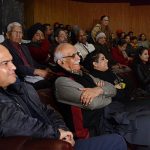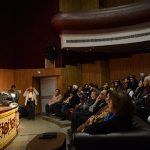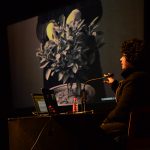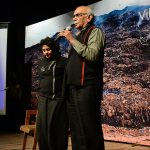Dr. M S Randhawa Auditorium
Punjab Lalit Kala Akademi
Punjab Kala Bhawan, Sector 16 B, Chandigarh, India
24 January 2019
Climacteric, is the first ever solo Exhibition of works by Vibha Galhotra in her hometown, Chandigarh. The exhibition includes photographs, film, video, sculptures and found material presented in the context of the environs Galhotra deals with in her day to day. Whether as a conceptual artist, thinker, environmental activist, or an ordinary inhabitant of Delhi – art gives her the freedom to communicate to the world at large, the latter being undeniably altered and possibly irreversibly damaged by human activity.
In the show, Galhotra references the effluvial sludge clogging up the Yamuna River – undeniable material and visible toxic evidence of the slow devastation of the health of an entire city’s inhabitants – to engage her audiences, to get us to inquire about living in the age of the Anthropocene. The latter is characteristic of “the Great Climacteric”, referring to a period of critical transition, in this case ecological. Consequently, Galhotra, through her exhibition, takes centerstage in calling attention to this Climacteric, forcing both artists and audiences to question their own role and level of engagement with the social, economic, political and ethical implications of climate change, urging us to go beyond a mere aesthetic presentation of these issues in our practices.
Galhotra’s understanding of the environment comes from her own childhood experiences of suffering from breathing issues and the resulting isolation which led her to form what she calls “friendships” with plants who she called her mates. Her memories include a childhood spent in nature, a time when the Yamuna was still a clean river, its banks witness to family excursions. Years later, however, the river had turned into a sewage and, to Galhotra, it seemed almost as if the black river was in mourning.Personal is political and her own memories of lush green landscapes and a blue fresh river were at loggerheads with what she observed in her formative years as an artist and these informed her artistic practice, which she says is also a way of taking responsibility for what all of us have done to our rivers, land and air.
As a primary witness of such juxtapositions, Galhotra looks at the many issues that are interlinked with the innocence of a child who has lost the world of her past, the grown up who is ridden by anxiety to see the river of her childhood dying, and as an artist who believes art has a social responsibility.
The exhibition, then, is an amalgamation of works from different series produced by the artist along with some new works creating a transitory “in-between” space where one questions, discusses, introspects and searches, accepting responsibility, rather than simply prescribing a final conclusion or solution.
Galhotra, transformed the gallery into an immersive space, considering familiar and unanticipated elements, ranging from the Panchabhuta (earth, water, fire, air and ether) to aesthetic representations of Anthropogenic climate patterns and consequences including a film juxtaposing the beliefs and reality of the scared Yamuna river introducing audiences to an aestheticized toxicity that while draws them in through curiosity, however, leaves them unsettled with the present state of affairs on their way out.
Capturing the climate of the present, the exhibitionimplores us to find a solution before it’s too late. We are deep-rooted in the Climacteric. ‘NOW’ is the emergency.
About the Artist
Vibha Galhotra (b. 1978, India) grew up in different cities of North India. Preceding her studies at the Government College of Art, Chandigarh and at the Kala Bhavan, Visva Bharati University, Santiniketan, she spent few years travailing before settling in Delhi in 2005. Drawing from her experiences of living in a culturally diverse country racing towards being developed, Galhotra became interested in the subject of Anthropocene, extending her prior research on belief and reality to the latter. Galhotra’s practice crosses the dimensions of art, ecology, economy, science, spirituality, and activism and constantly tries to create a parallel between belief and reality, absence and presence, construction or [De] construction within the social, political and economic domain of our constructed structures. The constant negotiation of human with ecosystem and with the mysteries within that ecosystem, interest her to continue her practice based on research and intuitive imagination to understand and question the alienation of humans in the atmosphere as also the atmosphere in the human dominated world.
Vibha Galhotra is a recipient of the prestigious Rockefeller Grant at their Bellagio Center, 2016 and the Asian Cultural Council fellowship in the US, 2017. She has been honored with the YFLO Woman Achiever of the Year Award in 2015, Inlaks Foundation Fine Arts Award in 2005-06, the National Scholarship from the Human Resource Department, Government of India in 2001-02, and the Artist Under 30 Award, Chandigarh State Lalit Kala Academy Award in 1998.
She will be receiving the Asia Art Future award by Asia Society this February.





































